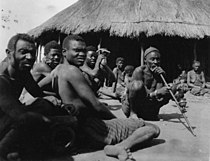Lenje people (also known as Bene Mukuni, Balenje, Balenge, Benimukuni, Ciina mukuna, Lenge, Lengi[1][2]) is an ethnic group in Zambia. They are loosely bound with its spatial and cultural boundaries shifting, depending on whom you talk to.[3] They live mainly in the Central province but also in Lusaka and Copperbelt province. It is not clear when they arrived to the area where they live today[2] but they are believed to be among the first people to come to Zambia from the Cameroon region.[citation needed] It has been claimed that they have been in the area at least since the 17th century.[4] The Lenje chiefdom comprises one senior chief and seven subordinate chiefs and chiefdoms.[5] They are about 240 000[citation needed] - 310 000[6] and are considered to be part of the Bantu, Central-South people cluster within the Sub-Saharan African affinity bloc.[6] They are related to the neighboring Tonga people[7][8] and have also been said to be related to the Twa (or Batwa, Awatwa) of the Lukanga Swamps.[9][10]
 Lenje chief smokes pipe. Photo by Eric von Rosen 1911-1912. | |
| Total population | |
|---|---|
| 310 000 in | |
| Languages | |
| Lenje, English | |
| Related ethnic groups | |
| Lukanga Twa, Tonga people |
Subsistence
editTravellers who visited Lenje in the beginning of the 20th century writes that they were mainly farmers but hunting and fishing was also important.[11] Present day Lenje are generally subsistence farmers growing maize during the rainy season and vegetables during the dry season, They burn charcoal as well as keep a few cattle, goats, chickens etc. Some, especially those closer to the edge of the Lukanga swamp, fish or are involved in fish trade.[2]
References
edit- ^ "Lenje - Collections Online | British Museum". www.britishmuseum.org. Retrieved 2021-11-04.
- ^ a b c Kachali, Rhoda Nthena (2007). Stakeholder interactions in Wetlands: Implications for Social Ecological System Sustainability - A Case of Lukanga Swamps, Zambia (PDF). Lund University.
- ^ Rosén, L. (2020). Territory, property and state making in Lenje Chiefdom (PDF). p. 71.
- ^ Sicard, H.; Vogel, J. (1969). On the Peoples of the Zambezi, Current Anthropology, Volume. 10, No. 4, Part 2. pp. 465–466.
- ^ Shamutuku, Rackson (2010). "Zambia: Kulamba Kubwalo Ceremony - Uniting Lenje People".
- ^ a b PeopleGroups.org. "PeopleGroups.org - Lenje of Zambia". peoplegroups.org. Retrieved 2021-10-20.
- ^ "Lenje". Oxford Reference. Retrieved 2021-11-04.
- ^ Siwila, Lilian Cheelo (2015). "An Encroachment of Ecological Sacred Sites and its Threat to the Interconnectedness of Sacred Rituals: A Case Study of the Tonga People in the Gwembe Valley". Journal for the Study of Religion. 28 (2): 138–153. ISSN 1011-7601. JSTOR 24805695.
- ^ Macrae, F.B (1934). The Lukanga Swamps, The Geographical Journal, Vol. 83, No. 3. pp. 223–227.
- ^ Rosen, Eric von (1916). Träskfolket; Svenska Rhodesia-Kongo-expeditionenes etnografiska. Smithsonian Libraries. Stockholm, A. Bonniers förlag. p. 395.
- ^ Rosen, Eric von (1913). Från kap till Alexandria: reseminnen från svenska Rhodesia-Kongo-expeditionen (in Swedish). A. Bonniers. p. 30.